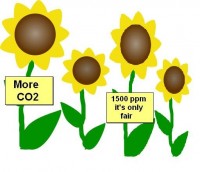By Dr. Vincent Gray, NZ Climate Truth Newsletter
We are daily told that Paific Islands are “threatened” with rising sea levels. Yet many estasblished measurements, for example in Tuvalu, do not agree.
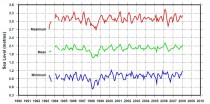
In 1990 the Australian Government became so worried about the obstinacy of the measurements that they launched The South Pacific Sea Level and Climate Monitoring Project (SPSLCMP0. This has placed the most sophisticated equipment ever developed (SEAFRAME) on 12 Pacific Islands Cook Islands, Federated States of Micronesia (only from 2003), Fiji, Kiribati, Marshall Islands, Nauru, Papua New Guinea, Samoa, Solomon Islands, Tonga, Tuvalu, and Vanuatu. The results are so startling that they have never been published in “peer reviewed” Journals and are only available on the websites . The main one is here although they try to rediredct you to the following site which provides the message “This page cannot be found”
A summary of the results was preesented by Philip Hall in 2006 here. However, this does not provide any of the actual records. It provides alleged “trends”, which are misleading.
The actual records can be found here. There are 12 seperate Reports, one for each island. They all contain the same initial section, which is concentrated in claiming that there are upward “trends” in sea level in every island. Only at the end do you get the a record of actual measurements by the SEAFRAME equipment, but only for that particular island. If you want to see all the records and compare them you have to download the twelve seperate Reports. .
My Report “South Pacific Sea Level: a Reassessment” here is the only paper which collects all of the actual measurements of sea level on all twelve islands.
The records all show a degree of irregularity. The seasonal change is present in all. The main irregularity is associated with the Tropical Cyclones and Tsunamis that affected all the islands at some time during the SEAFRAME measurements, which are usually since 1991. The dates of the cyclones and tsunamis for that particular island are given in each Report. The 1998 El Nińo cyclones are present on nearly all of them. They caused a depression in sea level which may be an artefact, due to disturbance of the region close to the instruments. They also seem to cause a slight jump in the measurementl which could be due to a disturbance in the level of the instrument. With Fiji, Nauru, Samoa, Solomons, Tonga, the measurement jumped slight;y upwards after the hurricane It seems very likely that the hurricane disturbed the equipment. In the year 2000 all of the instruments were equipped with an up-todate Global Positioning system, so the measurements after that date are the most reliable.
The anonymous scientists involved showed there were upwards “trends” based entirely on a linear regression on the whole series, including the first one or two figures, which could be influenced by teething troubles, and the disturbances caused by cyclones and tsunamis, They failed to notice that after the Global Poitioning equipment was installed in the year 2000 eleven of the twelve islands showed no change in sea level. Kiribati and Nauru showed no change since 1993, Cooks, Marshalls and Tuvalu since 1994, Papue New Guinea and Vanuatu since 1995. The Fedrated Stes of Micrnesia, starting in 2002, showed no change after 2003.
I conclude that the South Pacific Sea Level and Climate Monitoring Project has provided unequivocal evidence that sea level is not rising near any of the Pacific islands, and that they are not “threatened” in the way claimed.
It will be interesting to see what happens to the measurements as a result of the recent tsunamis. I would be glad to send my paper to anybody interested, but I thought I could hardly send all twelve records here. I have attached Tuvalu, which is persistently claimed to be sinking.
The question arises, is it typical? I think it quite likely that the phenomena shown here, of disturbance to equipment when subjected to hurricanes or severe weather, may be responsible for many of the records showing sudden upward jumps. The records are also subject to neighbouring land subsidence due to weight of buildins and removal of ground water and minerals. .
Many records begin to level off as soon as they install GPS; for example, Auckland (below)

The Topex/Poseidon/Jason satelite series shows a riise of sea level since 1993 but it has levelled out since 2006 , It might be subject to ocean oscillations more than sites adjacent to the land, which after all, are what matters to people who live there.
By Kevin Klees, Engineer
OK, I’ll start right off by admitting that I am a “Climate Change” Denier, Naysayer, Skeptic, Cynic, Disbeliever, Doubter, Doubting Thomas, Flat Earther, and any other phrases that you might find in your Thesaurus. There, I admit it. Do I feel guilty about the future of the planet? No, not in the least.
Why do I reach this decision?
Because, as an engineer I have extensive training on the actual limits placed on human activities by the LAWS OF PHYSICS. For more than a quarter of a century I have tried to design things that violate the LAWS OF PHYSICS. I am ashamed to admit that I HAVE NOT BROKEN ANY OF THEM YET. As an engineer I am in the FRONT LINES fighting the LAWS OF PHYSICS every day. So far the LAWS OF PHYSICS are winning, 99-0.
So, here is one of those NASTY little LAWS OF PHYSICS, it’s called the THIRD LAW OF THERMODYNAMICS. It can make for a really drowsy read, but the simple version states:
“IT IS IMPOSSIBLE TO TRAP HEAT”
Yep, that’s it, pretty simple; it means that there is NOTHING NATURE, OR A MAN/WOMAN CAN DO TO TRAP HEAT.
This LAW is demonstrated MILLIONS of times every day. When you put more insulation into the attic of your house, you are SLOWING the flow of heat from inside (umm, warm and toasty) to the outside (ugh, cold and wet). You are NOT TRAPPING HEAT.
Ask yourself this simple question; if a Greenhouse can “TRAP HEAT” why is it colder inside one in January than in August? Why can’t you “trap” the heat from August and use it during the whole rest of the year? Because of the THIRD LAW.
So, if the THIRD LAW is enforced in manmade greenhouses on the surface of the earth, why is it not enforced in the atmosphere of the earth? Simple answer, it applies equally in all locations.
So you are probably now asking, what’s that whole Lobotomy thing about? Back in the 1930’s and 1940’s there was a “consensus” that lobotomies’ were an effective treatment for mental disorders. Unfortunately, one sibling of a recently deceased US Senator from Massachusetts had this “therapy” applied to her. In fact, the doctor that “perfected” the lobotomy was awarded a Noble prize for his efforts to torture and cripple individual human beings. Of course, it was later determined that the “consensus” was “mistaken”. Whoops! The next “consensus” will certainly do better, we promise.
So are we really ready to perform a Lobotomy on the Economy of the United States of America by passing the CRAP AND TAX bill because a “consensus” is really really sure that; “most” of the (poorly measured) warming is “very likely” caused by human activities ? (UN IPCC statement, paraphrased slightly).
Should we commit economic suicide because a “consensus” is sure that MOST of the (poorly measured) warming is VERY LIKELY caused by humans? One definition of MOST is “more than half”, and the UN’s own definition of VERY LIKELY is 90%, so the UN is stating that 51% * 90% = 45% of the (poorly measured) “warming” is caused by human activities. Should we perform a self-inflicted lobotomy to “solve” a problem that has a likely occurrence of 45% ?
You should of course also know that the manufacturers of this “consensus” depend entirely on the propagation of the “consensus” for their livelihood i.e.: no consensus, no jobs. See more and contents here.
By Terence Corcoran
One of the big green lies about global warming science and climate change policy is that the issues are vicious battlegrounds between corporate interests and environmentalists. David Suzuki has been pushing this idea for years, at times going so far as to claim that the National Post and some of its editors/writers are corporate pawns and shills for big business’s anti-climate change agenda. One of Mr. Suzuki’s associates and chairman of the Suzuki Foundation, Jim Hoggan, operates a blog site and has a new book dedicated to the corporate-manipulation theme. Mr. Hoggan claims there exists a concerted public relations assault on climate science and policy that “could not be accomplished without the compliance of media as well as the assent and participation of leaders in government and business.” He talks of “a global PR machine that is too often in the service of special interests and too little concerned about the public interest.”
Let us now return to reality, where this idiot’s guide to climate policy making doesn’t survive 24-hours’ worth of news reports and press releases. The daily news flow is packed with evidence to the contrary and proof that the opposite is true: Big business and the globe’s greatest corporate powers are marching in lock step with governments and environmentalists to impose climate policy on the world and its people. At the Copenhagen climate conference in December, no group looks forward more fervently than big business to a global carbon control agreement filled with firm targets, big tax increases and massive subsidies for special interests all over the world.
If there’s a corporate-driven global PR machine, it’s firmly on the side of climate control, grinding out one corporate climate agenda after another, an avalanche of business-government co-operation the likes of which the world has never seen. And smack in the middle of this global PR machine, shifting the gears and greasing the wheels, are the world’s leading environmentalists and green NGOs: The World Wildlife Fund, David Suzuki, the Sierra Club, Environmental Defence, Forest Ethics, the Pembina Institute and many more. Together with industry, they pressure government in the creation of the green industrial state.
The shape of the green industrial state rises out of a not-so-attractive place in history. The two great theories of modern statism are part of the recent past: Communism has been dead for two decades, discredited with the fall of the Soviet Union; and full-blown fascism, with government in total control of a subservient corporate private economy, has been a non-starter since 1945. What we have now rising out of the ashes to fill the void is climatism.
Signs of climatism are everywhere. Here’s news yesterday from the Forest Products Association of Canada, whose president, Avrim Lazar, threw Canada’s forest firms behind a World Wildlife Fund campaign to stop global deforestation. Claiming Canada has no “net” deforestation - which means Canada does deforest, but offsets it by planting trees - Mr. Lazar said deforestation accounts for almost 20% of global greenhouse gas emissions. Could it be that Mr. Lazar’s forest firms are looking for other governments to take action that would favour Canadian industry?
On Tuesday, another green corporatist group - the Canadian ENGO-Industry Cap-and-Trade Dialogue - issued a final statement calling on the Canadian government to jump-start a national cap-and-trade carbon regime that would make no exceptions, for instance, for Canada’s rapidly expanding oil sands industry. The group’s members are a rogues gallery middlemen, energy consumers and green activists: The David Suzuki Foundation, Dow Canada, DuPont Canada, Environmental Defence, Forest Ethics, Pembina Institute, Royal Bank of Canada, Rio Tinto, Sierra Club of Canada, the Toronto-Dominion Bank and the World Wildlife Fund.
Looks like Jim Hoggan, chair of the Suzuki Foundation, is in bed with a mess of powerful corporations to promote their private interests so they can cash in on climate policy. The group also said it agreed with “the broad scientific view that the increase in global average temperature above pre-industrial levels ought not to exceed 2 degrees C.” Oh really. Did the Royal Bank’s risk department conduct the appropriate scientific assessment to determine the logic of global temperatures? Did they assess the risk of the bank being sucked into a perilous carbon trading market, carbon being a likely global investment bubble? Or is the bank just keen to rake in the billions that could be made trading credits and doling out loans to fund carbon credit purchases?
Corporate fingerprints, smudged with government and green group participation, is nowhere more evident than in the climate-driven rush into renewable energy. In Ontario, the list of corporations supporting and circling the province’s new Green Energy Act is an appalling demonstration of climatism run amok. From TransCanada to GE, from wind farm developers to solar panel makers, it’s a corporatist free for all. All have joined forces with David Suzuki, Environmental Defence and other green groups in cahoots with government to install a regime that looks all to much like a giant swindle. Mr. Suzuki’s image, and his video support for their cause, is a fixture on the Ontario green energy web site.
The model for Ontario’s green renewable schemes is Germany, where climatism is well advanced and where solar and wind power programs - fuelled by the same feed-in tariffs proposed for Ontario - has created an economic fiasco. A new study, “Economic impacts from the promotion of renewable energies: The German experience,” published this month by the Rheinisch-Westfälisches Institut in Essen, Germany, found tens of billions had been wasted, consumers gouged, and carbon emissions essentially unchanged.
Also exposed in the German study (summarized elsewhere on this page) is the myth of “green jobs” from renewables. In Ontario, Rick Smith, head of Environmental Defence and a prominent front-man for renewable programs, boasted that since Germany created 250,000 green jobs, Ontario would create 50,000 green jobs. But Germany’s job creation is doubtful. The institute report said Germany created 50,000 jobs at most - but at a cost of $240,000 per job.
Renewable energy may well be the best demonstration yet of the folly of climatism. But there is much more to come, at Copenhagen and beyond. Last week, to pick one example, a Canadian green business summit boasted Walmart, Maple Leaf Foods, Coca-Cola Bottling, McDonald’s, Home Depot as leaders, with a keynote speech by David Suzuki titled, “Business, like every other sector in society, must understand that being green is about sustainability.” He’ll be speaking to the converted.
Formal state corporatism is unmarketable as a political model, but green industrial statism looks like a winner. Read more here.
Screenrant
Probably the number one point of conversation in our daily lives is the weather. What’s next on the most discussed list? I’d make a strong case for TV/movies: They’re something we’re all fans of, some to far more of an extent than others (can’t you tell we here at Screen Rant are an example of that?). But did you ever think that movies and the weather would collide (outside of a Roland Emmerich movie)? Well today, in a rather odd piece of news, that’s exactly what’s happened.

The guys over at /Film are reporting that The Weather Channel (yes, THE Weather Channel) will start showing movies starting the day before Halloween, October 30th, and every Friday thereafter. So what sort of movies will the channel be showing? Well, weather-related movies, of course! What else? Starting off the series - which runs from the end of October to the end of November - is the George Clooney and Mark Wahlberg disaster movie, The Perfect Storm, coinciding with the anniversary of the actual 1991 storm that the movie is based on.

TWC meteorologist Jen Carfagno will host “The Weather Channel Presents” series, providing an introduction to the film as well as relevant commentary on the particular movie’s weather-related themes. On top of the aforementioned The Perfect Storm, the series will also include March of the Penguins, Misery and Deep Blue Sea. During the film, viewers will still get their regular weather reports, appearing in the lower portion of the screen (wow that’s going to be irritating when you’re trying to watch a movie).
If you’re interested, you can check out the full press release over at /Film.
I guess in a way this move kind of makes some sort of sense, and will probably draw in some viewers that might not have tuned into the channel otherwise (who really goes specifically to the actual Weather Channel for their weather reports - don’t people use the radio or the Internet to find that out?).
Having said that, I wouldn’t be one of them. Admittedly I’m in the UK and don’t get access to the channel myself, but if I DID have access, I still wouldn’t tune in to watch a film on a Weather Channel. There are just too many other ways to fulfill my movie-watching needs, that DON’T have annoying weather reports popping up on-screen during the screening. It ranks right up there with talking, ringing phones and baby’s crying on the “Most Annoying Things While Watching Movies” meter.
Would you watch weather-related movies on The Weather Channel? Do you think it will wind up being popular with viewers?
Read more here.
First breakfast weather with Al Roker on TWC and now Friday night at the disaster movies, NBC which owns TWC continues to show the kind of judgement that has them at risk of being the first of the original three big networks to go under, and take TWC with it (unless they offload it to COMCAST). The Peacock turned green and now has lost its feathers and is becoming a turkey. Ratings reflect this. Back to TWC though, I can’t wait for the first Friday night with a blizzard raging, or a tornado outbreak slamming the plains and see the viewers tune in to find the “March of the Penguins”.
By John Coleman, Meteorologist KUSI-TV and the REAL Founder of The Weather Channel
“Where it gets completely wild is when you consider what kinds of things we can do to reduce carbon emissions,” Running said. “The technology doesn’t exist to do that now, without reducing our lifestyles to primitive levels.”
The Running in the above quote is University of Montana forestry professor Steve Running, who shared in the 2007 Nobel Peace Prize as a member of the United Nations Intergovernmental Panel on Climate Change (IPCC). He is heading up a new University of Montana degree program on Climate Change Studies. I agree with Running in his conclusion: If releasing Carbon Dioxide, CO2, into the atmosphere in the exhaust from the burning of fossil fuels is driving an irreversible global climate change that will destroy our way of life, we have no viable solution available. The only answer would be to return the jungle and live like Tarzan and Jane. That is why the debate about the effect of CO2 on climate is so vitally important.
However, I also know with absolute confidence that the result on climate from our release of CO2 into the atmophere in the exhaust from burning fossil fuels is only a tiny, insignificant impact on climate. So there is good news: we do not have any valid reason to reduce our lifestyles to the primitive level, as he professor suggests we might have to.
There is not a shadow of doubt, I conclude, that the IPCC hypothesis that radiative forcing as CO2 interacts with water vapor leads to a huge magnification of the greenhouse effect from CO2 has been proven wrong. The IPCC scientists never did have any real scientific proof of the theory, only computer models full of assumptions and a vote of the members of the group who all had a vested interest in the theory. The model projections, regardless of how they were structured, have failed to verify anyway. So there is no doubt about it, the carbon footprint, global warming mania is dead wrong.
But my absolute confidence in this matter makes little difference. I am simply an old meteorologist and don’t have any real influence on policy. So the University of Montana will have its new degree program and students will learn the litany of global warming as presented by Al Gore and UN IPCC. And, that is simply the smallest problem. Because the Supreme Court has endorsed the power of the Environmental Protection Agency to declare CO2 as a pollutant because it leads to global warming, the US congress is on the verge of passing Cap and Trade and the UN is about to come up with the Copenhagen Accord that will create a global government and tax the CO2 producing nations to pay for it.
This three fronted acceptance of CO2 as the global warming culprit and implementation of penalties for the burning of fossil fuel will cost us our way of life and our freedom. There are thousands of scientists and our supporters working to stop the Al Gore Global Warming, but we are totally outgunned by power and money. There is absolutely no significant money on our side, and in the end, I fear that is deciding factor.
That does not mean that I surrender. Never.
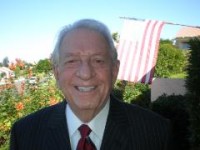
See post on Coleman’s Corner here.
------------------------------------------------
Massive snowstorm in Europe
By Bill Steffen, WOOD-TV Blog
The biggest snowstorm in 25 years hit central Europe with amounts up to five feet atop Zugspitze, the highest peak in Germany.
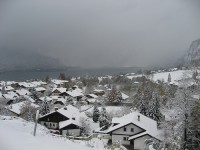
In Austria, two day snowfalls of 2-3 feet caused some ski areas to have their earliest-ever opening day. The Czech Republic, Slovakia and Poland were hit hard. Up to 20″ of snow fell in the mountains of the Czech Republic. Trees and power lines were toppled, with up to 700,000 customers without power during the unusual cold wave. In southern Poland three people froze to death. Huge waves destroyed a pier at Sopot in northern Poland. Tens of thousands of Ukrainians were without power after the storm. A major rail line from Switzerland to Austria was blocked by trees felled from the weight of the snow. The Polish government mobilized troops to assist the clean-up. Temperatures dropped to 11 above zero in southern Poland, extremely cold for this time of year.
Back in the U.S., check out the snow on top of Mt. Washington in New Hampshire. Mt. Washington hasn’t been above freezing in nine days. They had over a foot of snowfall in the first two weeks of October and temperatures for the month are more than 7 degrees cooler than average.

Chief Meteorologist Bill Steffen WOOD-TV
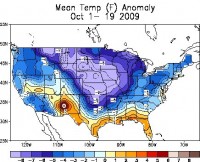
October 1-19 temperature anomaly enlarged here
By Edwin Mora, CNS News
Andrew Revkin, who reports on environmental issues for The New York Times, floated an idea last week for combating global warming: Give carbon credits to couples that limit themselves to having one child. Revkin later told CNSNews.com that he was not endorsing the idea, just trying to provoke some thinking on the topic.
Revkin participated via Web camera in an Oct. 14 panel discussion on “Covering Climate: What’s Population Got to Do With It” that was held at the Woodrow Wilson Center in Washington, D.C. The other participants on the panel were Dennis Dimick, executive editor of National Geographic, and Emily Douglas, web editor for The Nation magazine.
At the event, Revkin said: “Well, some of the people have recently proposed: Well, should there be carbon credits for a family planning program in Africa let’s say? Should that be monetized as a part of something that, you know, if you, if you can measurably somehow divert fertility rate, say toward an accelerating decline in a place with a high fertility rate, shouldn’t there be a carbon value to that?
“And I have even proposed recently, I can’t remember if it’s in the blog, but just think about this: Should--probably the single-most concrete and substantive thing an American, young American, could do to lower our carbon footprint is not turning off the lights or driving a Prius, it’s having fewer kids, having fewer children,” said Revkin.
“So should there be, eventually you get, should you get credit--If we’re going to become carbon-centric--for having a one-child family when you could have had two or three,” said Revkin. “And obviously it’s just a thought experiment, but it raises some interesting questions about all this.”
When CNSNews.com later followed up with questions about his comments, Revkin responded in an e-mail. “I wasn’t endorsing any of this, simply laying out the math and noting the reality that if one were serious about the population-climate intersection, it’d be hard to avoid asking hard questions about USA population growth,” wrote Revkin.
“By raising the notion of carbon credits for, say, single-child American families,” he continued, “I was aiming to provoke some thinking about where the brunt of emissions are still coming from on a per-capita basis.”
In a Sept. 19, 2009 blog entry, “Are Condoms the Ultimate Green-Technology?” Revkin cited an August 2009 study by the London School of Economics that highlighted having fewer children as a solution to diminishing our carbon footprint. The study was sponsored by the British activist group Optimum Population Trust, which advocates reduced population growth.
“More children equal more carbon dioxide emissions,” blogged Revkin. “And recent research has resulted in renewed coverage of the notion that one of the cheapest ways to curb emissions in coming decades would be to provide access to birth control for tens of millions of women around the world who say they desire it.
“I recently raised the question of whether this means we’ll soon see a market in baby-avoidance carbon credits similar to efforts to sell CO2 credits for avoiding deforestation,” he later added. “This is purely a thought experiment, not a proposal.”
Furthermore, he blogged: “But the issue is one that is rarely discussed in climate treaty talks or in debates over United States climate legislation. If anything, the population-climate question is more pressing in the United States than in developing countries, given the high per-capita carbon dioxide emissions here and the rate of population growth. If giving women a way to limit family size is such a cheap win for emissions, why isn’t it in the mix?”
Revkin earned a Master’s degree in journalism from Columbia University and a biology degree from Brown University.
Here is a transcript of that portin of Revkin’s remarks at the Oct. 14 panel discussion in which he suggested the possibility of giving people carbon credits for having fewer children:
“Well, some of the people have recently proposed: Well, should there be carbon credits for a family planning program in Africa let’s say? Should that be monetized as a part of something that, you know, if you, if you can measurably somehow divert fertility rate, say toward an accelerating decline in a place with a high fertility rate, shouldn’t there be a carbon value to that?
“And I have even proposed recently, I can’t remember if it’s in the blog, but just think about this: Should--probably the single most concrete and substantive thing an American, young American, could do to lower our carbon footprint is not turning off the lights or driving a Prius, it’s having fewer kids, having fewer children.
“So should there be, eventually you get, should you get credit--If we’re going to become carbon-centric--for having a one-child family when you could have had two or three. And obviously it’s just a thought experiment, but it raises some interesting questions about all this.” See story here and watch video here.
Icecap Note: Andy has two sons. ICECAP endorses the use of condoms and no children for elitists and alarmists.
Also see a new article on Andrew Revkin’s latest conspiracy theory. It seems NewsCorp. and Fox News are now in his cross-hairs.
By Joseph D’Aleo
October 17, 2009

A rare cloud formation was spotted over Moscow this week, inciting widespread discussion of UFO sightings throughout the city ‘ concerns which spread across the globe instantly via the internet. The British tabloid The Sun reported as a “Mystery UFO Halo’ over Moscow although it was likely simply an interesting natural phenomenon created by natural seeding of a thin cloud deck by ice crystals falling from above as in this amazing photo below (source here).
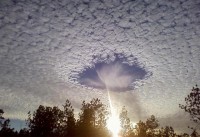
or better yet, this photo from Colorado from 2002.

Or is it artifical seeding of the cloud by the Russian Air Force as a test of the mayor of Moscow’s plan to reduce snow in Moscow this winter through cloud seeding.
Moscow Mayor Promises a Winter Without Snow
By Simon Shuster
Pigs still can’t fly, but this winter, the mayor of Moscow promises to keep it from snowing. For just a few million dollars, the mayor’s office will hire the Russian Air Force to spray a fine chemical mist over the clouds before they reach the capital, forcing them to dump their snow outside the city. Authorities say this will be a boon for Moscow, which is typically covered with a blanket of snow from November to March. Road crews won’t need to constantly clear the streets, and traffic - and quality of life - will undoubtedly improve.
The idea came from Mayor Yury Luzhkov, who is no stranger to playing God. In 2002, he spearheaded a project to reverse the flow of the vast River Ob through Siberia to help irrigate the country’s parched Central Asian neighbors. Although that idea hasn’t exactly turned out as planned - scientists have said it’s not feasible - this time, Luzhkov says, there’s no way he can fail. (See TIME’s photo-essay “Vladimir Putin: Action Figure.")

Controlling the weather in Moscow is nothing new, he says. Ahead of the two main holidays celebrated in the city each year - Victory Day in May and City Day in September - the often cash-strapped air force is paid to make sure that it doesn’t, well, rain on the parades. With a city budget of $40 billion a year (larger than New York City’s budget), Moscow can easily afford the $2-3 million price tag to keep the skies blue as spectators watch the tanks and rocket launchers roll along Red Square. Now there’s a new challenge for the air force: Moscow’s notorious blizzards.
“You know how every year on City Day and Victory Day we create the weather?” Luzhkov asked a group of farmers outside Moscow in September, according to Russian media reports. “Well, we should do the same with the snow! Then outside Moscow there will be more moisture, a bigger harvest, while for us it won’t snow as much. It will make financial sense.”
The plan was unsurprisingly rubber-stamped this week by the Moscow City Council, which is dominated by Luzhkov’s supporters. Then the city’s Department of Housing and Public Works described how it would work. The air force will use cement powder, dry ice or silver iodide to spray the clouds from Nov. 15 to March 15 - and only to prevent “very big and serious snow” from falling on the city, said Andrei Tsybin, the head of the department. This could mean that a few flakes will manage to slip through the cracks. Tsybin estimated that the total cost of keeping the storms at bay would be $6 million this winter, roughly half the amount Moscow normally spends to clear the streets of snow.
So far the main objection to the plan has come from Moscow’s suburbs, which will likely be inundated with snow if the plan goes forward. Alla Kachan, the Moscow region’s ecology minister, said the proposal still needs to be assessed by environmental experts and discussed with the people living in the area before Luzhkov can enact it. “The citizens of the region have some concerns. We have received lots of messages,” she told the RIA news agency.
With only a few weeks left before winter comes, environmentalists will have to work fast to keep Luzhkov from implementing his zaniest plan to date - and to stop the first snowflakes from wafting down to the city streets. See story here.
One bit of advice to Mayor Luzhkov,- ban Al Gore this winter as cold and snow follows him to his public appearances (see Gore effect).
By Ryan Maue
With the Northern Hemisphere Tropical Cyclone (TC) seasons winding down in the Eastern Pacific and North Atlantic, it is as good as time as any to take account of what the Earth has offered during the past 12-months in terms of TC Accumulated Cyclone Energy (ACE). Since the last Southern Hemisphere season was quite uneventful with well-below normal ACE, and the continued Northern Hemisphere inactivity, the sum of the two = global ACE has fallen off the table.
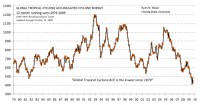
The global ACE index enlarged here.
The current ACE represents the tropical cyclone activity from January 1, 2009 until the date indicated. This is readily compared to the YEARLY value which is the previous 30-year average from Jan 1 - Dec 31 or the calendar year. The values through October 31 and November 30 represent the previous 30-year average as well with the average October ACE indicated in the last cell. There is considerable year-to-year variability across the basins, of which understanding motivates the updating and maintenance of this site.

Table enlarged here.
Comparisons through October 12
What is the current state of tropical cyclone activity compared to the same date during the past 30-years? This comparison table highlights the GLOBAL, SOUTHERN HEMISPHERE, and NORTHERN HEMISPHERE totals for the previous 12 and 24-months, respectively.
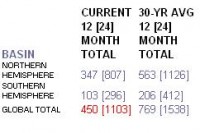
Table enlarged here.
Note: The Accumulated Cyclone Energy metric combines frequency, duration, and the intensity of tropical cyclones into one value that can be calculated from historical storm records as well as current operational center (i.e. NHC) advisories. The ACE is simply the wind speed squared (times 10^4 kts^2) for each 6-hour storm location and intensity estimate—added up for an entire season or whatever period you wish to define. CLIMO based upon 1979-2008 climatology See Ryan’s tropical page here. Al Gore please note.
Also Kevin Trenberth please note. Looks like it is YOUR AMS posting that was shameful (see Roger Pielke Jr.’s post here). You and the AMS owe Roger Pielke Jr and Chris Landsea apologies for your bloviation proven to be as wrong as the IPCC forecasts.
Wall Street Journal Online
The recent corporate resignations from the U.S. Chamber of Commerce have played in the media as a case of enlightened corporate stewardship vs. blinkered old businesses. But there’s far more to this story - not least the way that Apple and Nike are putting green political correctness above the long-term interests of their own shareholders.
The Chamber needs “a more progressive stance on this issue” of climate change, declared Apple Vice President Catherine Novelli in a letter of resignation from the business lobby on October 5. Added Nike, announcing its resignation on September 30 from the Chamber board though retaining its membership: “US businesses must advocate for aggressive climate change.” Both decisions were ostentatiously leaked to the media.
The first point to understand is the role of Al Gore, who is a member of the Apple board and perhaps the leading supporter of President Obama’s cap-and-tax anticarbon legislation. Mr. Gore has also invested in renewable energy technologies that could make him even richer than he already is if new climate rules make renewables more competitive with carbon energy.
Meanwhile, Apple’s Chief Operating Officer Tim Cook happens to sit on the board of . . . Nike. We’re told that Nike CEO Mike Parker didn’t discuss the Chamber move with his full board of directors before it was announced, and Nike didn’t return our phone call asking for comment. In any case, we doubt it’s an accident that Nike and Apple acted against the Chamber at the same time - and just when Democrats are trying to build new momentum for cap and trade in the Senate.
Both companies may figure they can afford a U.S. carbon tax because most of their manufacturing is done outside the U.S. Apple has an enormous “carbon footprint” of some 10 million annual tons of emissions to make and use its power-hungry gadgets. But nearly all of those products are made in China and other Asian countries where there are no carbon limits and aren’t likely to be any time soon, if ever. According to calculations based on Apple’s emissions figures, were the company to manufacture in the U.S., the Boxer-Kerry bill pending in the Senate would hit Apple with carbon taxes between $43 million and $108 million a year.
Nike, meanwhile, makes most of its shoes and apparel in 700 contract factories in countries such as South Korea and Vietnam - which also won’t sign up for the Boxer-Kerry energy tax. The larger point is that neither Apple nor Nike would pay as much under a cap-and-trade bill as, say, the maker of Bobcat excavators in Bismarck, N.D., or your average Midwest natural gas utility. Green virtue is easier when someone else is paying for it.
Yet even this self-interested calculation is likely to be short-sighted for both companies. Since climate change is a global issue, green activists won’t stop their carbon pursuit at the U.S. border. It wouldn’t be long after cap and trade passed in the U.S. that Nike and Apple were pressured to move their manufacturing out of countries that haven’t signed Kyoto II. That would threaten their production lines and cost structure, with potential damage to sales and competitiveness.
And if the companies fail to relocate, the next anticarbon lobbying policy step will be a carbon tariff against products made in China or Vietnam and sold in the U.S. A carbon tariff is already part of the House cap-and-trade bill and is gaining currency among Congressional protectionists, most recently Senator Lindsey Graham (R., S.C.). As companies that import nearly all of their products, Apple and Nike would be especially vulnerable. We wonder if Messrs. Cook and Parker thought through any of this before committing their employees and investors to this crusade.
The Chamber’s great sin, according to Nike and Apple, is that it questioned the Environmental Protection Agency’s right to regulate all greenhouse gases without new legislation. The Chamber has said that while it supports Congressional efforts to regulate emissions, it opposes EPA’s attempt to grab that power for itself on the basis of an elastic reading of the Clean Air Act. This is a major issue for many Chamber members.
If companies are going to dump the Chamber over a single dispute, then the overall influence of business in Washington is likely to decline. The Chamber’s job isn’t to favor one company’s agenda over another but to stand broadly for free trade, low taxes and limited regulation - principles that help U.S. business as a whole.
Having abandoned their business allies on climate change, Apple and Nike might wake up one day to discover they need those friends on one of their crucial issues. It will serve them right if they find themselves alone in the Beltway square. See story here.
Dr. William Gray and Dr. Kevin Trenberth Debate Global WarmingWhat Happened To Global Warming?
So reads the headline of a recent BBC article, which continues: This headline may come as a bit of a surprise, so too might that fact that the warmest year recorded globally was not in 2008 or 2007, but in 1998. But it is true. For the last 11 years we have not observed any increase in global temperatures. This isn’t really news, though it will probably come as such to environmentalists and all the people who have bought into their propaganda.
The following is Part 1 of a written debate between Dr. Kevin Trenberth - head of the Climate Analysis Section at the National Center for Atmospheric Research in Boulder - and Dr. William Gray, Professor Emeritus of Atmospheric Science at Colorado State University. This debate originally appeared in the Fort Collins Forum: Editor’s note: While the issue of anthropogenic global warming is much more than a local issue, we are fortunate to have two leading authorities on climate science in Northern Colorado. Each has a different view of the issue and agreed to this in-paper debate. The Forum believes this type of direct debate is all too rare on this topic and thank doctors Gray and Trenberth for their efforts. The Forum also wants to thank author Ray Harvey for bringing them together for this debate.
We Are Not In Climate Crisis by Dr. Bill Gray, Professor Emeritus of Atmospheric Science at Colorado State University
Ask ten people on the street if mankind’s activities are causing global warming, and at least eight will say yes. This is because nearly 20 years of gross exaggeration on the part of scientists, environmentalists, politicians, and media; most of whom wish to profit in some way from the public’s lack of knowledge on the topic-have distorted the subject of human-induced global warming out of all sensible proportion. Many have been lead to believe that Al Gore’s movie and book An Inconvenient Truth provides incontrovertible evidence that human-induced global warming is a real threat. Yet, contrary to what is heard from warming advocates, there is considerable evidence that the global warming we have experienced over the last 30 years and over the last 100 years is largely natural. It is impossible to objectively determine the small amount of human-induced warming in comparison to the large natural changes which are occurring.
Many thousands of scientists from the US and around the globe do not accept the human-induced global warming hypothesis as it has been presented by the Intergovernmental Panel on Climate Change (IPCC) reports over the last 15 years. The media has, in general, uncritically accepted the results of the IPCC and over-hyped the human aspects of the warming threat. This makes for better press than saying that the climate changes we have experienced are mostly natural. The contrary views of the many warming skeptics have been largely ignored and their motives denigrated. The alleged “scientific consensus” on this topic is bogus. As more research on the human impact on global temperature change comes forth, more flaws are being found in the hypothesis.
It must be pointed out that most climate research is supported by the federal government. All federally sponsored researchers need positive peer-reviews on their published papers and grant proposals. This can be difficult for many of the “closet” warming skeptics who receive federal grant support. Many are reluctant to give full expression of their views, primarily because of worries over continuing grant support. It is difficult to receive federal grant support if one’s views differ from the majority of their peers who receive support to find evidence of the warming threat. The normal scientific process of objectively studying both sides of the question has not yet occurred. Such open discussion has been largely discouraged by warming advocates.
Implementation of the proposed international treaties restricting future greenhouse gas emissions by as much as 20 to 80 percent of current emissions would lead to a large slowdown in the world’s economic development and, at the same time, have no significant impact on the globe’s future temperature.
Many of the Global Climate Model (GCMs) simulations by large US and foreign government laboratories and universities, on which so much of these warming scenarios are based, have some very basic flaws. These global models are not able to correctly model the globe’s small-scale precipitation processes. They have incorrectly parameterized the rain processes in their models to give an unrealistically enhanced warming influence to CO2. This is the so-called positive water-vapor feedback. The observations I have been analyzing for many years show that the globe’s net upper-level water vapor does not increase but slightly decreases with warming. These GCMs also do not yet accurately model the globe’s deep ocean circulation which appears to be the primary driving mechanism for most of the global temperature increases that have occurred over the last 30 and last 100 years. GCMs should not be relied upon to give global temperature information 50 to 100 years into the future. GCM modelers do not dare make public short-period global temperature forecasts for next season, next year, or a few years hence. This is because they know they do not have shorter range climate forecasting skill. They would lose credibility if they issued shorter-range yearly forecasts that could be objectively verified. Climate modelers live mostly in a “virtual world” of their own making. This virtual world is isolated from the real world of weather and climate. Few of the GCM modelers have any substantial weather or short-range climate forecasting experience. It is impossible to make skillful initial-value numerical predictions beyond a few weeks. Although numerical weather prediction has shown steady and impressive improvement since its inception in 1955, these forecast improvements have been primarily made through advancements in the measurement (i.e. satellite) of the wind and pressure fields and the advection/extrapolation of these fields forward in time 10-15 days. For skillful numerical prediction beyond a few weeks, it is necessary to forecast changes in the globe’s complicated energy and moisture fields. This entails forecasting processes such as amounts of cloudiness, condensation heating, evaporation cooling, cloud-free radiation, air-sea moisture- temperature flux, etc. It is impossible to accurately code all these complicated energy moisture processes, and integrate these processes forward for hundreds of thousands of time-steps and expect to obtain anything close to meaningful results. Realistic climate forecasting by numerical processes is not possible now, and, because of the complex nature of the earth’s climate system, they may never be possible.
Global temperatures have always fluctuated and will continue to do so regardless of how much anthropogenic greenhouse gases are put into the atmosphere. The globe has many serious environmental problems. Most of these problems are regional or local in nature, not global. Forced global reductions in human-produced greenhouse gases will not offer much benefit for the globe’s serious regional and local environmental problems. We should, of course, make all reasonable reductions in greenhouse gases to the extent that we do not pay too high an economic price. We need a prosperous economy to have sufficient resources to further adapt and expand energy production.
Even if CO2 is causing very small global temperature increases there is hardly anything we can do about it. China, India, and Third World countries will not limit their growing greenhouse gas emissions. Many experts believe that there may be net positive benefits to humankind through a small amount of global warming. It is known that vegetation and crops tend to benefit from higher amounts of atmospheric CO2, particularly vegetation which is under temperature or moisture stress.
I believe that in the next few years the globe is going to enter a modest cooling period similar to what was experienced in the 30 years between the mid-1940s and the mid-1970s. This will be primarily a result of changes in the globe’s deep-ocean circulation. I am convinced that in 15-20 years we will look back on this period of global warming hysteria as we now look back on other popular and trendy scientific ideas that have not stood the test of time. [End]
See Dr Trenberth’s reply (Global Warming: Coming Ready Or Not by Kevin Trenberth, Head of the Climate Analysis Section at the National Center for Atmospheric Research here and Bill Gray’s strong Part II comeback followed by Dr Trenberth’s Part II here.
By Joseph D’Aleo, AMS Fellow, CCM, October 12, 2009
In this recent post, we discussed the problems with recent data that showed the argument presented by the EDF’s millionaire lawyer playing clueless environmentalist on Lou Dobbs Tonight that this will be the warmest decade is nonsense. This claim was well refuted and Al Gore’s credibility disassembled by Phelim McAleer, of the new documentary Not Evil, Just Wrong that challenges the lies and exaggerations (totalling 35) in Al Gore scifi horror comedy film, An Inconvenient Truth. 9 were serious enough for a UK judge to require a disclaimer itemizing them be read whenever, the movie was shown in the schools.
The world’s climate data has become increasingly sparse with a big dropoff around 1990. There was also a tenfold increase in missing months around the same time. Stations (90% in the United States which has the Cadillac data system) are poor to very poorly sited and not properly adjusted for urbanization. Numerous peer review papers suggest an exaggeration of the warming by 30%, 50% or even more. The station dropout can be clearly seen in the two maps below with the number of station going from over 6000 to just 1079 from April 1978 to April 2008.
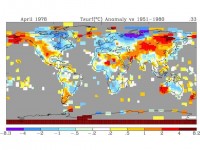
April 1978 global plot. See larger image here
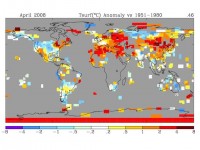
April 2008 global plot. See larger image here
See the big gaps in the recent data in Canada, Greenland, Africa, South America, parts of western Asia, parts of Australia.
SEE FOR YOURSELF
Take this test yourself to see how bad a shape the global data base is. Look for yourself following these directions using the window into the NOAA GHCN data provided by NASA GISS here.
Point to any location on the world map. You will see a list of stations and approximate populations. Locations with less than 10,000 are assumed to be rural (even though Oke has shown that even a town of 1,000 can have an urban warming of 2.2C).
You will see that the stations have a highly variable range of years with data.
Try and find a few stations with data that extends to 2009. To see how complete the data set is for that station, click in the bottom left of the graph Download monthly data as text.
For many, many stations, you will see the data set in a monthly tabular form has many missing data months mostly after 1990 (designated by 999.9).

See larger image here
This required the data centers to estimate data for the grid box for that location with other stations nearby (homogenization). In the 2008 plot above only 1079 stations were used. NASA went to locations within 250 km (155 miles) to find data for the grid boxes. For grid boxes without stations within 250 km, they are left blank, thus the large gaps.
Most of the stations that dropped out were rural. More of the missing data points are having their missing months filled in with more urban data in the grid boxes.
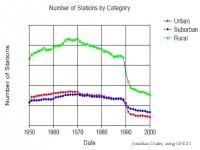
See larger image here
One example of how good or bad this works is from Maine. Volunteers completed surveys of the United States Historic Climate Network (USHCN) temperature stations in Maine for Anthony Watts surface station evaluation project. The survey determined that every one of the stations in Maine was subject to microclimate or urbanization biases. One station especially surprised the surveyors, Ripogenus Dam, a station that was officially closed in 1995.
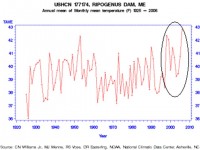
See larger image here
Despite being closed in 1995, USHCN data for this station is publicly available until 2006! (GISS stopped in 1995)
Part of the USHCN data is created by a computer program called “filnet” which estimates missing values. According to the NOAA, filnet works by using a weighted average of values from neighboring stations. In this example, data was created for a no longer existing station from surrounding stations, which in this case as the same evaluation noted were all subject to microclimate and urban bias, no longer adjusted for. Note the rise in temperatures after this before the best sited truly rural station in Maine was closed. GISS does display this station that did incorporate the “filnet” data input for missing months although as noted they stopped its plot in 1995 which NOAA extended artificially to at least 2006.
How can we trust NOAA/NASA/Hadley assessment of global changes given these and the other data integrity issues? Given that Hadley has destroyed old original data because they were running out of room in their data cabinet, can we ever hope to reconstruct the real truth?
As one of our scientist readers noted: “Well, the 999.9s you showed me today sure opened my eyes...the ramifications are stunning. I knew about the drop-off of stations before but never that existing station reports are so full of gaps or that they’re getting temperature readings from “ghost” stations. This is, as you have said, GARBAGE. See PDF here.
US NWS North Platte, Nebraska
Snowfall Records Fall With First Snow Of The Season
A new snowfall record was set for the month of October, when 13.8 inches was observed at the National Weather Service Office at North Platte Regional Airport. The old record occurred way back on October 29th and 30th 1896, when 13.0 inches was observed. Snow depths of over a foot and a half were reported in and around the North Platte area. Snow fell continuously from 8 pm CDT Friday evening until 10 am CDT Saturday morning. An unusually strong Arctic cold front ushered in temperatures from the upper teens to middle 20s by mid evening Friday. As a strong Polar jet stream acted to bring persistent lift to the area Friday night, moderate snow fell continuously across the Nebraska Panhandle into west central and central Nebraska. Because the airmass was unusually cold, this caused the snow to be rather light and fluffy, thus the high snowfall totals.
See this report to the southest out of Hastings, NE. Here is a photo from that site.
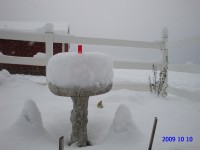
------------------------
Early Austrian snow records set to be broken
By Lisa Chapman, Austrian Times
Austria’s provincial capitals are expected to see their earliest snowfalls in history today (Monday) as Arctic air sweeps the country.
Josef Haselhofer from Vienna’s Central Agency for Meteorology and Geodynamics (ZAMG) said today (Monday) Arctic air would probably result in the first snow cover in provincial capitals before 20 October in history and said Innsbruck, Salzburg and St. Polten were likely to see snow.
He said as much as 30 to 40 centimetres of snow was likely down to 1,200 metres and snow could fall as low as 400 metres later this week, adding it had already begun to fall in Vorarlberg. He also predicted low temperatures would be minus five degrees at higher elevations and zero degrees in the lowlands by Thursday morning.

Haselhofer warned of possible impassable snow drifts in some places and the danger of avalanches in low-lying areas.
Car club OAMTC reported today that chains were mandatory for all vehicles on stretches of the Arlbergstrabe (L197), Lechtalstrabe (L198) and the Silvretta-Hochalpenstrabe (L188) in Vorarlberg.
The club said snow was falling down to 1,500 metres and the snow line would drop to as low as 900 metres in the province before it stopped snowing there.
The record for early snow in provincial capitals was set in 2007, when snow remained on the ground in some of them from 20 to 24 October. The average high in October, according to ZAMG, is 15 degrees.
The snow warnings come after weather records tumbled last week, with a number of places seeing records for the highest October temperature in many years, according to ZAMG.
It said records had been set on 7 October in Vienna-Donaufeld, with a high of 28.6 degrees, the highest in 50 years, and in Grobenzersdorf, Lower Austria, with a high of 28.5 degrees, the warmest October day there in history.
By John Kerry and Lindsay Graham, New York Times
CONVENTIONAL wisdom suggests that the prospect of Congress passing a comprehensive climate change bill soon is rapidly approaching zero. The divisions in our country on how to deal with climate change are deep. Many Democrats insist on tough new standards for curtailing the carbon emissions that cause global warming. Many Republicans remain concerned about the cost to Americans relative to the environmental benefit and are adamant about breaking our addiction to foreign sources of oil.
However, we refuse to accept the argument that the United States cannot lead the world in addressing global climate change. We are also convinced that we have found both a framework for climate legislation to pass Congress and the blueprint for a clean-energy future that will revitalize our economy, protect current jobs and create new ones, safeguard our national security and reduce pollution.
Our partnership represents a fresh attempt to find consensus that adheres to our core principles and leads to both a climate change solution and energy independence. It begins now, not months from now - with a road to 60 votes in the Senate.
It’s true that we come from different parts of the country and represent different constituencies and that we supported different presidential candidates in 2008. We even have different accents. But we speak with one voice in saying that the best way to make America stronger is to work together to address an urgent crisis facing the world. This process requires honest give-and-take and genuine bipartisanship. In that spirit, we have come together to put forward proposals that address legitimate concerns among Democrats and Republicans and the other constituencies with stakes in this legislation. We’re looking for a new beginning, informed by the work of our colleagues and legislation that is already before Congress.
First, we agree that climate change is real and threatens our economy and national security. That is why we are advocating aggressive reductions in our emissions of the carbon gases that cause climate change. We will minimize the impact on major emitters through a market-based system that will provide both flexibility and time for big polluters to come into compliance without hindering global competitiveness or driving more jobs overseas.
Second, while we invest in renewable energy sources like wind and solar, we must also take advantage of nuclear power, our single largest contributor of emissions-free power. Nuclear power needs to be a core component of electricity generation if we are to meet our emission reduction targets. We need to jettison cumbersome regulations that have stalled the construction of nuclear plants in favor of a streamlined permit system that maintains vigorous safeguards while allowing utilities to secure financing for more plants. We must also do more to encourage serious investment in research and development to find solutions to our nuclear waste problem.
Third, climate change legislation is an opportunity to get serious about breaking our dependence on foreign oil. For too long, we have ignored potential energy sources off our coasts and underground. Even as we increase renewable electricity generation, we must recognize that for the foreseeable future we will continue to burn fossil fuels. To meet our environmental goals, we must do this as cleanly as possible. The United States should aim to become the Saudi Arabia of clean coal. For this reason, we need to provide new financial incentives for companies that develop carbon capture and sequestration technology.
In addition, we are committed to seeking compromise on additional onshore and offshore oil and gas exploration - work that was started by a bipartisan group in the Senate last Congress. Any exploration must be conducted in an environmentally sensitive manner and protect the rights and interests of our coastal states.
Fourth, we cannot sacrifice another job to competitors overseas. China and India are among the many countries investing heavily in clean-energy technologies that will produce millions of jobs. There is no reason we should surrender our marketplace to countries that do not accept environmental standards. For this reason, we should consider a border tax on items produced in countries that avoid these standards. This is consistent with our obligations under the World Trade Organization and creates strong incentives for other countries to adopt tough environmental protections.
Finally, we will develop a mechanism to protect businesses - and ultimately consumers - from increases in energy prices. The central element is the establishment of a floor and a ceiling for the cost of emission allowances. This will also safeguard important industries while they make the investments necessary to join the clean-energy era. We recognize there will be short-term transition costs associated with any climate change legislation, costs that can be eased. But we also believe strongly that the long-term gain will be enormous.
Even climate change skeptics should recognize that reducing our dependence on foreign oil and increasing our energy efficiency strengthens our national security. Both of us served in the military. We know that sending nearly $800 million a day to sometimes-hostile oil-producing countries threatens our security. In the same way, many scientists warn that failing to reduce greenhouse gas emissions will lead to global instability and poverty that could put our nation at risk.
Failure to act comes with another cost. If Congress does not pass legislation dealing with climate change, the administration will use the Environmental Protection Agency to impose new regulations. Imposed regulations are likely to be tougher and they certainly will not include the job protections and investment incentives we are proposing.
The message to those who have stalled for years is clear: killing a Senate bill is not success; indeed, given the threat of agency regulation, those who have been content to make the legislative process grind to a halt would later come running to Congress in a panic to secure the kinds of incentives and investments we can pass today. Industry needs the certainty that comes with Congressional action.
We are confident that a legitimate bipartisan effort can put America back in the lead again and can empower our negotiators to sit down at the table in Copenhagen in December and insist that the rest of the world join us in producing a new international agreement on global warming. That way, we will pass on to future generations a strong economy, a clean environment and an energy-independent nation.
John Kerry is a Democratic senator from Massachusetts. Lindsey Graham is a Republican senator from South Carolina.
Chris Horner on Planet Gore:
Sens. John Kerry and Lindsey Graham have a piece in today’s New York Times stumbling through a pro-cap-and-trade routine. Initial thoughts on this homage to the bipartisanship fetish: The “we even have different accents” bit tips their hand that the argument is as substantive as those adds with Sharpton and Robertson on a couch together. Not a bad parallel actually, though I can’t help but recall this far more entertaining version of the labored intro. When one feels compelled to give six reasons why we ought to embrace their idea, you know they aren’t persuaded themselves he “global warming” argument, and see little persuasive opportunity in it. The piece is on occasion incoherent. See the, er, paragraph, of seemingly unrelated statements with the general theme of economy and trade: We cannot sacrifice any more jobs to competitors (but no comment as to what a provision making energy more expensive would do to help that). India and China have decided to make windmills and solar panels (because rich countries have vowed to spend billions on them...how illuminating). We should penalize any countries that don’t do this too (defeating the implicit but wisely unstated argument that this will help our economy).
To end by quivering over the EPA threat to do this if we don’t succumb to legislation, which is a threat that Congress could avoid with a stroke of a pen about 1,300 pages shorter than the House bill is the epitaph to this inanity.
By Christine Hall
October 5, 2009
CEI Petitions EPA to Reopen Global Warming Rulemaking
Washington, D.C., October 6, 2009 - In the wake of a revelation by a key research institution that it destroyed its original climate data, the Competitive Enterprise Institute petitioned EPA to reopen a major global warming proceeding.
In mid-August the University of East Anglia’s Climate Research Unit (CRU) disclosed that it had destroyed the raw data for its global surface temperature data set because of an alleged lack of storage space. The CRU data have been the basis for several of the major international studies that claim we face a global warming crisis. CRU’s destruction of data, however, severely undercuts the credibility of those studies.
In a declaration filed with CEI’s petition, Cato Institute scholar and climate scientist Patrick Michaels calls CRU’s revelation “a totally new element” that “violates basic scientific principles, and “throws even more doubt” on the claims of global warming alarmists.
CEI’s petition, filed late Monday with EPA, argues that CRU’s disclosure casts a new cloud of doubt on the science behind EPA’s proposal to regulate carbon dioxide. EPA stopped accepting public comments in late June but has not yet issued its final decision. As CEI’s petition argues, court rulings make it clear that agencies must consider new facts when those facts change the underlying issues.
CEI general counsel Sam Kazman stated, “EPA is resting its case on international studies that in turn relied on CRU data. But CRU’s suspicious destruction of its original data, disclosed at this late date, makes that information totally unreliable. If EPA doesn’t reexamine the implications of this, it’s stumbling blindly into the most important regulatory issue we face.”
Among CRU’s funders are the EPA and the U.S. Department of Energy - U.S. taxpayers.
Read the CEI petition to the EPA.
Read more about the data dump: The Dog Ate Global Warming, by Patrick J. Michaels
The data from the Hadley Data Centre, NOAA and NASA (the three station based data repositories) is seriously contaminated and can’t be used for trend analysis. Numerous peer review papers have indicated exagerrated warming of 30%, 50% or even more.
The global data bases suffer from a dropout of 80% of the world’s stations around 1990, a tenfold increase in missing months in remaining sites especially in the FSU and Africa, use of data designed for aviation purposed with large error tolerances for temperatures rendering them unusable for small trend changes and instruments with known warm biases that went uncorrected (HO-83), removed or absence of urban heat island adjustment despite numerous peer review papers (including two by data centre heads - Karl 1988 and Jones 2009) that indicated the importance of such adjustment, bad siting for instruments or shelters - 90% of the 1000 surveyed in the United States and early indications of similar issues internationally that result in warm biases. The data centers then perform a final adjustment to the data (little to no documentation as to exactly, what or why) that includes what they call ‘homogenization’ which involves combining anomalies for stations in a region that results in a degradation of the accuracy for any well sited and accurate stations that may exist.
These land issues were augmented by issues over the oceans. The world is 71% ocean. Hadley only trusts their own merchant ship data, mainly derived from northern hemisphere routes. Hadley has virtually no data from the southern hemisphere’s oceans (80% of the hemisphere). NOAA and NASA use ship data reconstructions. The gradual change of buckets to ship intakes for taking ocean temperature measurements introduces uncertainties. Different sampling levels will make results slightly different. How to adjust for this introduced difference and get reliable data set has yet to be resolved adequately, especially since the transition occurred over many decades. NOAA included satellite data measurements (infrared and microwave) but announced in July 2009 the removal of satellite data due to ‘complaints’ about a cold bias in the southern hemisphere. The immediate result was a jump up of global ocean and ocean land temperatures and ‘new record warmth for the global oceans in July and August. This jump was similar to the jump up when urban adjustment was removed by NOAA for the US in 2007. Read more here.
To see for yourself how bad the global data sets are, go to the GISS map here at the top of the map box choose “raw GHCN data with USHCN corrections” instead of the default “combining sources at the same location” which mixes cities and rural. Then point at any part of the world and see how pitiful the data set is that is used to make those charts and graphs the alarmists love so much. If any plot has gaps go to the bottom left and click “Download monthly data as text” and see all the missing months and gaps in the data (999.9).
Global temperature analyses by NOAA, NASA and Hadley is seriously flawed far beyond from the uncertainty caused by lost original data.
By Paul Bedard, Washington Whispers
A noted geologist who coauthored the New York Times bestseller Sugar Busters has turned his attention to convincing Congress that carbon dioxide emissions are good for Earth and don’t cause global warming. Leighton Steward is on Capitol Hill this week armed with studies and his book Fire, Ice and Paradise in a bid to show senators working on the energy bill that the carbon dioxide cap-and-trade scheme could actually hurt the environment by reducing CO2 levels.
“I’m trying to kill the whole thing,” he says. “We are tilting at windmills.” He is meeting with several GOP lawmakers and has plans to meet with some Democrats later this week.

Don Quixote and Sancho Panza by Pablo Picasso
Much of the global warming debate has focused on reducing CO2 emissions because it is thought that the greenhouse gas produced mostly from fossil fuels is warming the planet. But Steward, who once believed CO2 caused global warming, is trying to fight that with a mountain of studies and scientific evidence that suggest CO2 is not the cause for warming. What’s more, he says CO2 levels are so low that more, not less, is needed to sustain and expand plant growth.
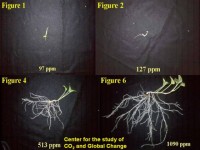
Trying to debunk theories that higher CO2 levels cause warming, he cites studies that show CO2 levels following temperature spikes, prompting him to back other scientists who say that global warming is caused by solar activity.
In taking on lawmakers pushing for a cap-and-trade plan to deal with emissions, Steward tells Whispers that he’s worried that the legislation will result in huge and unneeded taxes. Worse, if CO2 levels are cut, he warns, food production will slow because plants grown at higher CO2 levels make larger fruit and vegetables and also use less water. He also said that higher CO2 levels are not harmful to humans. As an example, he said that Earth’s atmosphere currently has about 338 parts per million of CO2 and that in Navy subs, the danger level for carbon dioxide isn’t reached until the air has 8,000 parts per million of CO2.
Steward is part of a nonprofit group called Plants Need CO2 that is funding pro-CO2 ads in two states represented by two key lawmakers involved in the energy debate: Montana’s Sen. Max Baucus and New Mexico’s Sen. Jeff Bingaman. See more here.
